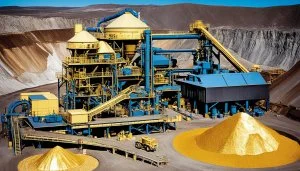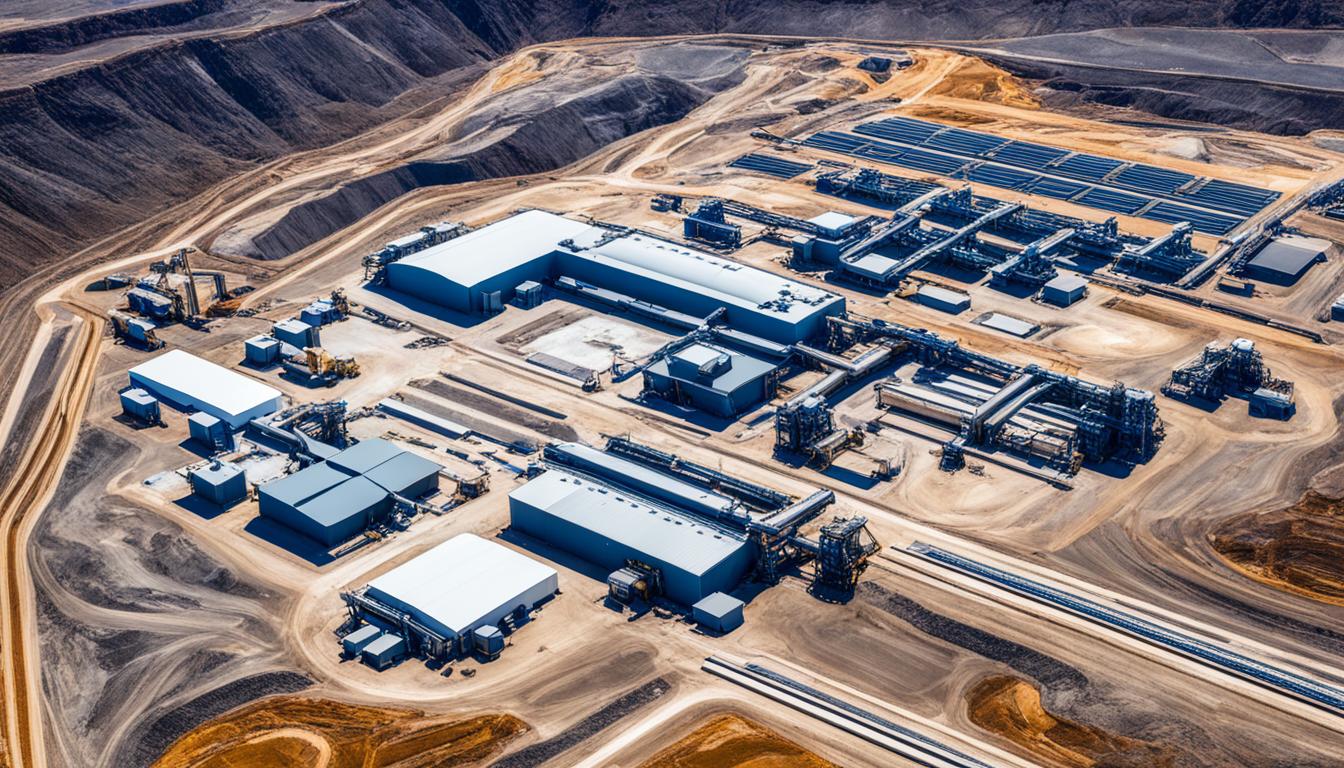
Table of Contents
TogglePursuing precious metals has long been rooted in human history, with gold processing standing as a testament to our evolving mastery over the natural world. The transformation of gold from raw ore to a refined state of brilliance is not merely a matter of aesthetics but an intricate ballet of ore preparation and sophisticated chemical interactions. Delving into refining precious metals, one discovers the alchemistic dance between fire and metal, where gold’s lustrous allure is brought forth.
To appreciate the full spectrum of gold production methods, we must first recognize gold’s vibrant hues and unrivalled flexibility, which have captivated civilizations across ages. Herein lies the cornerstone of gold’s coveted status, a constant through centuries of human development and cultural advancement. We embark on a journey to unravel the secrets behind this time-honoured practice, exploring the science and art of turning unassuming ore into the crowning glory of mankind’s treasures.
In an era where innovation is king, the gold processing industry continues to reinvent itself, melding ancient wisdom with cutting-edge technology. Through the splendid alchemy of gold processing, we endeavour to illuminate the intricate techniques that shape not only the backbones of economies but also the dreams of artisans and the legacy of empires. Accompany us as we traverse the golden thread that weaves through humanity’s past and present, forecasting a shimmering future refined through the millennia.
The Historical Journey Of Gold Processing
The legacy of gold begins far beneath the earth’s crust, where the allure of this precious metal initially captivated the human spirit. A chronicle rich with the artistry of goldsmithing techniques and the sophistication of gold-refining, the timeline of gold processing history is as lustrous as the metal itself. This odyssey through time reveals a consistent thread where economics, technology, and culture intertwine, mapping the transformative arc from ancient gold mining practices to cutting-edge extraction methods.
Early Gold-Refining Methods And Cultural Influence
The ancients wielded fire and simple tools, mastering the metallurgy necessary to produce objects of immense beauty and worth. From the hieroglyphics of Egypt to the treasuries of ancient Greece, evidence abounds of early gold processing. These civilizations harnessed the methods to separate gold from earth and rock and revered the metal for its intrinsic value and role in religious artefacts.
Milestone Discoveries In Gold Processing
- Amalgamation process enabling the recovery of gold from the ore
- Use of hydraulic mining techniques in the Californian gold rush
- Introduction of sophisticated assaying methods during the height of the Australian gold rush
The Evolution From Ancient Techniques To Modern Technology
In the wake of the Industrial Revolution, an unprecedented scale of gold production emerged. Pioneers like Emil Wohlwill and E.B. Miller engineered processes that demonstrated the highest echelons of purity and efficiency, propelling gold refining into the modern age. Recognizing the significance of these technological strides is pivotal when appreciating the shimmering artefacts and bullion that unite bygone epochs with today’s technological prowess.
Gold’s Unique Properties And Extraction Challenges
The allure of gold has captivated societies for centuries, mainly due to its mesmerizing lustre and rarity. But beyond its aesthetic appeal, gold’s chemical stability and resistance to oxidative corrosion make it an ideal asset for long-term value storage and diverse applications in jewellery, electronics, and even space technology. However, these same features present unique hurdles in gold extraction and processing, demanding a combination of technological prowess and experienced insight to harness its full potential.
Physical Characteristics Making Gold Valuable And Distinctive
Elemental gold’s intrinsic value is rooted in its distinctive physical characteristics. The electrons in gold’s atom absorb less yellow light, presenting the famously rich golden hue that has made it a treasured commodity across civilizations. Its flexibility allows it to be drawn into thin wires without losing integrity, making it invaluable in precision electronic applications. Yet, while gold is non-reactive and excels in both form and function, obtaining pure gold is anything but straightforward.
Challenges Of Element Stability And Compound Formation In Extraction
Gold’s aforementioned chemical stability paradoxically introduces extraction challenges. Its placidity means it does not readily react to form compounds with oxygen or hydrogen, enabling it to retain purity through millennia. However, when it comes to separating gold from refractory gold ore or other minerals, the industry faces a problem. Procedures like heap leaching or sodium cyanide solutions must be employed to dissolve gold into soluble complexes for recovery, requiring meticulous control and significant expertise.
- Refractory gold ores demand extensive preprocessing, such as roasting or pressure oxidation, to break down the sulfide matrix and liberate gold particles.
- Strict environmental regulations and public scrutiny shape the methodologies employed, pressing for more sustainable and less toxic alternatives to conventional chemical treatments.
- Increasingly scarce, easy-to-mine gold deposits push the boundaries of technology, necessitating ever more efficient and effective extraction techniques to sustain production.
Despite these complexities, the relentless pursuit of gold continues. It is a testament to human ingenuity that new methods emerge as each layer of challenge is peeled back, highlighting a relentless pursuit that has stood the test of time.
Geographical Distribution Of Gold Reserves
The quest for gold has spurred a global scavenger hunt as nations explore the earth’s crust in search of this precious metal’s lustrous allure. Geography’s impact on gold reserves is so profound that it not only shapes the physical methods of extraction but also influences the economies of countries rich in this prized resource. Let us delve into the contours of gold mining geography and uncover its influence on the pursuit and handling of gold reserves.
The cartography of gold reserve distribution offers a veritable atlas through time and space, from ancient civilizations to bustling modern mining operations. It is within such geological tapestries that the rich narrative of gold mining unfolds—each location harbouring different chapters, techniques, and tales of fortunes built.
The Impact Of Geography On Gold Mining Methods
From the icy tundras of Siberia to the sunburned landscapes of the Australian outback, geography sets the stage for the drama of gold extraction. The scattered geography implies that no two mines operate under identical conditions. It necessitates adaptation to each environment—a surrender to the geological script inscribed by nature’s hand. Here, the gold mining geography asserts its reign and human ingenuity rises to meet its demand.
- Surface deposits in Alaska beckon for placer mining operations.
- Subterranean veins in the Peruvian Andes require advanced underground techniques.
- Arid conditions in the Nevada desert demand efficient water reclamation methods.
Case Study: The Witwatersrand Of South Africa
Embark with me on a journey to the heart of South Africa, where the Witwatersrand gold deposit lies as a golden artery—a repository that once fueled nearly half the world’s gold production. Witwatersrand, the prodigious gold cradle, encapsulates the essence of mining evolution. This vast gold deposit has challenged, inspired, and enriched mining methodologies and economies on a colossal scale for over a century.
- Discovery in 1886 prompted a rush of miners, giving birth to Johannesburg.
- Techniques have evolved from simple panning to deep-level mining, pushing human ingenuity to the limits of engineering prowess.
- By its peak, it carved out 40 percent of the gold shimmering commercially across the globe, dictating international gold standards and market flows.
The narrative woven by the Witwatersrand deposit is a geological masterpiece that resonates with mining propositions across geological theatres worldwide. Here, a profound truth is etched into the ore itself: knowledge and respect for the geographic character of gold reserves are paramount in mastering the art of gold mining, whether in pursuit of the rich veins of Witwatersrand or any other corner of the gold-imbued Earth.
Gold Ore Types And Gold Processing
Delving into the intricacies of gold ore types is essential for understanding their unique processing requirements. The classification into exogenetic and endogenetic gold ores provides a framework that influences every subsequent step in the complex journey of gold extraction.
Distinguishing Between Exogenetic And Endogenetic Gold Ores
The enigmatic beauty of gold originates from deep within the Earth and on its surface. Exogenetic gold ores are a testament to the transformative power of the planet’s geological processes. These deposits, often found in sedimentary riverbeds, are shaped by aeons of surface weathering. In stark contrast, the enigmatic endogenetic gold ores are born from the fiery depths within the Earth’s crust, forged by geological forces that create rich vein and lode deposits.
Recognizing the origins of gold ore deposits is not merely academic; it is a critical factor dictating the appropriate gold processing techniques for those seeking to unearth the secrets of these deposits. The alluvial treasures of exogenetic ores have historically been captured by simple placer mining methods—the tools of ancients and prospectors alike. Yet the sophisticated bonds of gold entwined with iron sulfides in endogenetic ores defy such simple means, demanding more advanced and nuanced techniques.
Mining Considerations For Different Gold Ore Deposits
- Exogenetic Gold Ores: Given their formation through the ravages of time and the elements, these ores frequently gift miners fine, elemental gold particles. Hence, extraction leans towards panning and sluicing, exploiting the density contrasts to separate gold from sediment.
- Endogenetic Gold Ores: Concealed within the cryptic heart of Earth’s crust, these gold deposits intertwine with minerals that challenge traditional methods. Alternatives such as flotation and the pervasive use of cyanide leaching emerge as the champions for releasing finely disseminated gold from its mineral prison.
In a world that venerates efficiency, the necessity of aligning mining strategies with the nature of the specific gold deposit cannot be overstated. The relentless pursuit of gold – from the sedimentary riverbeds to the most profound veins of the Earth – is a testament to humanity’s tenacity and ingenuity. These enduring efforts to optimize the recovery and processing of these precious ores encapsulate the search for wealth and a deep understanding of Earth’s bountiful mysteries.
Gravity Concentration Techniques In Gold Extraction
Gold extraction and mining industries have long hailed gravity concentration for its precise ability to recover gold through density differences. This method, steeped in history, enjoys a reputation for high efficiency and minimal environmental impact. Placer gold mining, in particular, benefits from gravity concentration, yielding substantial returns by employing this seasoned technique.
Assessing The Efficacy Of Gravity Concentration Methods
The crucial aspect in determining the efficacy of gravity separation lies in its suitability for the ore in question. Miners have long known that gold’s significant density, unlike other minerals, allows for a more straightforward separation and extraction process. Choosing the right gold extraction equipment is crucial as it can significantly influence the purity and quantity of gold recovered.
Equipment Used In Gravity Concentration
Selecting suitable gravity concentration equipment is integral for optimizing gold recovery efforts. Below is a list of equipment commonly employed in the mining industry:
- Mineral jigs: An essential tool for heavy particle separation.
- Shakers: Utilized to sort materials for different densities.
- Sluice boxes: A simple yet effective means to recover gold from running water.
- Centrifugal concentrators: Highly beneficial for concentrating fine gold particles.
Adapting to the gold’s particulate size and overall ore concentration enhances mining operations’ recovery rates. Such adaptability makes gravity concentration a cost-effective option and a champion of environmentally conscious gold processing. As placer gold mining continues to evolve, effective gravity separation remains a cornerstone of efficient gold extraction.
Flotation – A Contemporary Gold Processing Method
As the quest for efficient gold extraction methods continues, flotation gold processing emerges as a forward-thinking technique dedicated to optimizing sulfide ore separation. This advanced method plays on minerals’ natural hydrophobicity to achieve unparalleled segregation, carving a niche for itself in the modern gold processing landscape.
Understanding The Basics Of Flotation In Gold Processing
Flotation harnesses the principle of hydrophobicity – where certain mineral surfaces repel water – to separate valuable gold from waste rock. Bubbles are introduced into a pulp of finely ground ore and water, and as the hydrophobic particles attach to the bubbles, they rise to the surface. This frothy mineral-bubble mixture is then skimmed off for further processing. Its precision in extracting gold from complex ores, including sulfides, makes flotation a valuable addition to mining technology.
Advantages And Limitations Of Flotation In Mineral Processing
The advantages of flotation are numerous, promising potential high recovery rates and the efficient processing of complex ores. Yet, it’s not without its share of limitations. Let’s dissect these points:
- Enhanced Recovery: Flotation can capture particles that other processes may miss, heightening overall gold recovery.
- Specificity: Its ability to target sulfide ores caters to specific mineral processing needs.
- Scalability: Flotation systems can be adapted to various scales, albeit with an eye on investment and environmental considerations.
Conversely, the limitations pose real challenges:
- The complexity of flotation demands significant technical expertise, putting it beyond the scope of simpler operations.
- In-depth environmental and regulatory approvals are necessary due to potential impacts.
- The initial and operational costs can deter small to medium-sized mining entities from adopting this technique.
In conclusion, implementing flotation in gold processing requires a calculated approach, weighing its advantages against its more demanding aspects. For those capable of navigating its complexities, flotation remains an integral asset in the mining industry’s repertoire.
The Role Of Cyanide In Gold Processing
In pursuing gold, methods and materials have been refined to optimize the extraction process. Among these, cyanide leaching is a cornerstone of modern gold extraction techniques.
Exploring The Cyanide Leaching Process
Cyanide leaching is a method that has transformed the gold mining industry with its effectiveness and efficiency. The process involves a chemical reaction between cyanide and the minute particles of gold found within ore, forming a solubilized gold-cyanide solution. From this solution, gold is later recovered, often by carbon adsorption. This technique benefits low-grade ores, where traditional methods would prove economically unviable. As such, cyanide leaching has become indispensable in gold extraction.
Addressing Environmental Concerns With Cyanide Use
Though efficient, cyanide use has its tradeoffs, primarily concerning its environmental impact. Its inherent toxicity is a cause for concern, prompting rigorous regulations to manage its use. These concerns are not unfounded, as cyanide spills have led to water contamination and wildlife harm. In response, the industry has adopted stringent protocols to mitigate these risks, including closed-loop systems and the destruction of wastewater cyanide. While some regions have banned cyanide in gold extraction outright, others permit it under tight controls. Only well-equipped facilities that can adhere to these strict environmental safeguards should employ cyanide leaching.
- Introduction of cyanide detoxification systems
- Development of alternative gold leaching agents
- Implementation of real-time monitoring and rapid response plans
- Commitment to rehabilitation and restoration post-operation
The balance between resource extraction and ecological well-being has never been more critical in the quest for precious metals. Ongoing innovations and improvements in the handling of cyanide in gold processing reflect a broader commitment to responsible mining practices.
Gold Processing Stages From Exploration To Closure
The path from discovering golden prospects to closing down the gates of a depleted gold mine encompasses a complex sequence of stages, each critical to the overall gold mine lifecycle. Below, we delve into the pivotal phases that guide a mine from its first glimmer of potential to its final acts of environmental stewardship.
Initial Exploration And Prospecting Challenges
Embarking on the journey of exploration and prospecting demands a significant investment of time and resources and a staunch resolve in the face of slim odds for success. Geologists and mining engineers scrutinize geophysical data and assay mineral samples to uncover a cache that could transform into the next lucrative mine. This early phase can be a decade-long venture, teeming with anticipation and uncertainty.
Development And Operation Of A Gold Mine
Once a promising gold deposit has been identified, mine development begins. This multi-faceted period involves everything from environmental impact assessments to constructing mining facilities and auxiliary infrastructure. Local communities often find new opportunities for growth alongside these developments, reaping the benefits of improved access ways and amenities. The following operational phase can span several decades, during which extraction methods evolve to reflect prevailing market demands and innovations in mining technology, each striving towards more efficient and conscientious gold production.
Mine Closure And Post-Closure Responsibilities
As profitable gold harvesting wanes or when other economic factors conclude a mine’s life, mine decommissioning takes centre stage; this process isn’t merely about shutting down operations but also a commitment to restoring the land. Meticulous deconstruction of the mining facilities goes hand in hand with environmental rehabilitation, ensuring the site’s return to a stable state. Post-closure care is further provided to monitor the efficacy of reclamation efforts and address ongoing responsibilities, solidifying the mining enterprise’s legacy of responsibility.
Technological Advancements In Gold Processing
The relentless progression of technology is radically redefining the gold production landscape. Against this tech-driven revolution, groundbreaking gold processing innovations are charting a new direction towards a more efficient and ethical mining industry. These pioneering advancements are the progenitors of increasingly automated mining processes and the adoption of sophisticated mining technology, propelling the sector forward.
Innovations Leading To More Efficient Gold Extraction
The drive for efficiency has given rise to novel extraction methods and supportive technologies that minimize waste and amplify gold yield. Electrification of mining equipment underpins the migration from diesel to electric power, a transition that significantly reduces emissions and, by extension, the mining footprint. In parallel, integrating digital technologies, such as real-time data analytics and sensor-based sorting, optimizes ore processing, yielding dramatic efficiency improvements in gold processing innovation.
- Electrification of mining fleets
- Real-time data and analytics for process optimization
- Advances in ore sorting and pre-concentration techniques
- Use of non-toxic solvents for eco-friendly gold leaching
The Future Of Gold Mining: Sustainability And Automation
The crystallization of a sustainable ethos in gold mining is more than a passing trend; it is the cornerstone of the industry’s future. An ensemble of cutting-edge solutions—including water reclamation systems, renewable energy sources, and benchmarking sustainable practices—is placing sustainable gold mining at the forefront. Coupled with these developments is the emergence of pervasive automation, propelling mining into the era of automated mining processes that guarantee worker safety and operational continuity.
- Implementation of renewable energy solutions
- Development of closed-loop water systems
- Strides in environmental reclamation and biodiversity conservation
- Deployment of autonomous vehicles and remote-control operations centres

As we set our sights on the horizon, it is evident that the synergy of technology, environmental stewardship, and innovative thinking is crafting the next chapter in gold extraction. The amalgamation of gold processing innovation and enduring commitment to our planet’s welfare signals the evolution of mining technology and the dawn of an era wherein gold mining coexists harmoniously with sustainable development.
Conclusion
As we reflect upon the vast narrative of gold processing, it’s evident that we stand at a transformative juncture in the industry’s evolution. The strides in elevating the efficiency and safety of gold extraction mirror a broader commitment to reshaping the sector’s relationship with our planet. Gold processing improvements have continually been implemented, reflecting our unyielding pursuit of perfection in the art and science of metallurgy.
Summarizing Gold Processing Enhancements And Industry Outlook
The metamorphosis of gold processing techniques has been remarkable, from the ancient crucibles of human civilization to the high-tech laboratories of the modern age. The gold industry outlook remains buoyant as technological frontiers extend, promising an era of more responsible and sustainable resource utilization. Driven by eco-friendly gold processing advancements, we are embracing methods that minimize environmental impact and maximize value extraction, ensuring the industry’s legacy endures conscientiously.
Reflecting On The Interplay Between Technology, Economy, And Environment In Gold Processing
The golden threads of technology, economy, and environment are intricately woven together in the narrative tapestry of gold processing. Each advancement in processing is a testament to the harmonious balance achievable between these elements. Our collective ambition is not just to maintain but to propel the golden legacy with an insightful approach that nurtures the economy, harnesses the power of innovation, and profoundly respects the ecological fabric of our world. In this pursuit, the nexus of ethics and attainment in gold processing casts a lustrous vision for the future—a future where the brilliance of gold is matched only by the brilliance of our stewardship.









